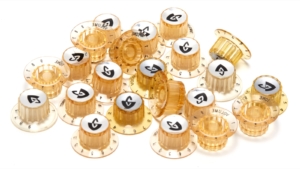
Introduction
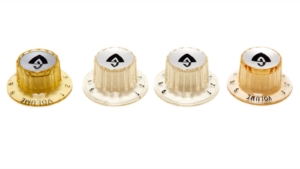
Since I often restore Guilds, I’ve ended up with a collection of various parts in order to do so including the pile of clear knobs that you see at the top of this page. But are they all the same? If not, how many different types are there? I started by sorting my pile into obvious differences and then compared them to pictures of guitars in my collection that I know to have original parts.
What I discovered was three main differences that I’ve split into four different categories to more closely line up with the commonly seen Guild factories that produced them. Let’s take a look at them in chronological order.
1960s (Hoboken)
These knobs are from a Hoboken guitar, but they were likely also used in the early days of Westerly.
The numbers are very slightly embossed into the underside of the skirt and the depth of the impression is filled with black. The font used on these knobs is distinctive in that it’s slightly larger and has a thinner weight than all the other knobs on this page and the knobs tend to be very amber in color due to their age. This example is from 1966, so they had been gracefully aging for 52 years when this picture was taken.
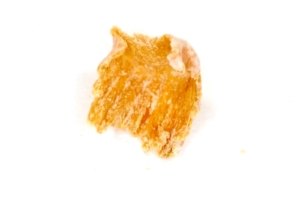
1990s (Westerly)
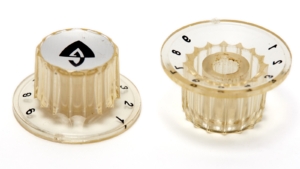
These knobs also have a rim around the bottom of the skirt that the ’60s and Newark St. knobs don’t seem to have. This rim forms a visible ring around the skirt that, in addition to the lack of the Volume/Tone labels, makes for an easy way to identify that these are Westerly knobs, though as we’ll see, the Corona knobs are pretty much identical. The numbers are printed in black on the underside of the skirt and do not seem to be raised or embossed. The ink can be scraped off, though this would be difficult without removing the knobs from the guitar.
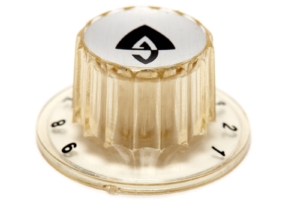
These knobs are the clearest of the bunch. Though they’re not 50+ years old, the ones in my possession are from the mid-late ’90s which makes them almost 25 so I’d imagine that they probably won’t change much more than they already have.
2000s (Fender – Corona)
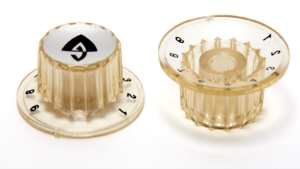
The numbers are printed in black on the underside of the skirt and are not raised or embossed. The ink can be scraped off, though this would be difficult without removing the knobs from the guitar.
These knobs have the same bit of flash on them, the same rim around the skirt, the same lack of Volume/Tone labels and appear to be the same as the Westerly knobs in every way.
2010s (Newark St. – Korean)
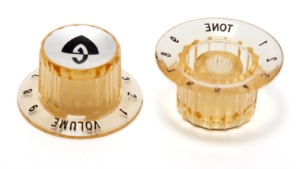
These knobs are similar in color to the Hoboken knobs, but they’re only a year old (if that) so they’ve been colored this way from the factory as opposed to having aged over time.
These knobs have a more modern font than the Hoboken knobs with a more bold appearance, though without them side by side the difference can be hard to discern. The main difference to look for is the fact that the numbers and letters are imprinted in the top of the skirt.
The silver G-shield on the top of the knob appears to be closer to the rim on these knobs than it does on the others, though again that’s a difference that might be tough to notice without viewing them next to vintage knobs. See the next image for an example.
But Do They Fit?
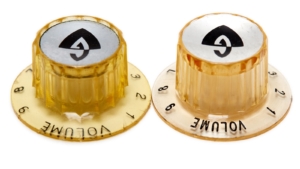
Here’s the big question: Are all of these knobs interchangeable? At first I thought the answer was yes, but I’ve since determined that this is not the case. As with everything in life, it’s not that simple, though. Let’s see why.
There are usually only a couple of things to worry about with guitar knobs. We need knobs to match the shaft which is usually either split or smooth since smooth shafts requires a set screw while split shaft knobs do not.
Next, we generally ask if the pots are imperial or metric because import guitars usually come with metric parts while US-made guitars, especially of the vintage variety, came with imperial parts. This is where it all gets not-so-simple because there’s one more aspect of potentiometer shafts that we should be concerned with, but in all my years I’ve never heard anyone mention it until recently on the LetsTalkGuild forum. That topic is splines. If you don’t know what splines are, consider them kind of like the teeth on a gear. They are indentations down the shaft in which a matching pattern in the hole on the bottom of the knob interlocks to make them stay on and not slip when turned. Split-shaft pots have another defining characteristic, and that’s the number of splines on the split part of the shaft.
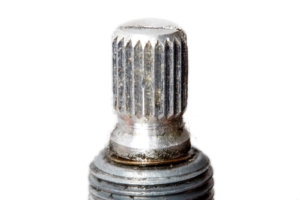
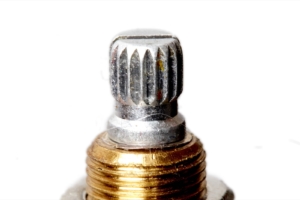
Can you mash the coarse-spline Newark St. knobs onto the fine-spline US-made pots on your vintage Guild? Probably, but you’ll find that it’s really hard to get them on there (and even more difficult to get them off), and they may not sit quite right, but since Newark St. knobs are $10 a pair vs. the ridiculous price people get for vintage knobs on Ebay, does it really matter? It will if you crush the split shaft together so that vintage knobs will no longer fit. You may also crack the new knob.
By the way, here is a pic of all four of the knobs with their matching splines that will get crushed if you use the wrong knob.
Conclusion
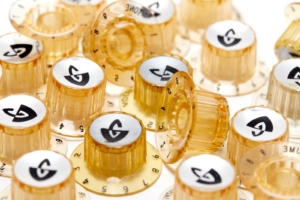
Hopefully that’s more information than you ever thought you’d need pertaining to Guild clear G-shield knobs. As usual, I didn’t think there would be so much detail when I started this project almost 1700 words ago.
Donate: PayPal Crypto:
ETH: 0x0AC57f8e0A49dc06Ed4f7926d169342ec4FCd461
Doge: DFWpLqMr6QF67t4wRzvTtNd8UDwjGTQBGs

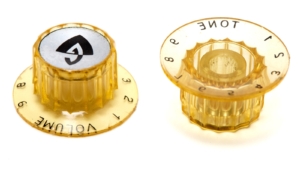
Interesting that the numbers appear upside down, compared to other knobs on other guitars. If you have any extra Westerly made knobs, I will gladly pay for them. I have one decal shield missing on one of four knobs, and as you mention the Newark St. knobs do not fit….
Regards,
Tom
I have a broken knob on a Bluesbird, and I’m planning to replace it. The guitar has serial number CL001927, which isn’t included in Guild’s Serial Number Chart, so I’m not even sure when it was made, but probably after 1999. The knob has no “VOLUME” or “TONE” designation on it, the numbers are indented on the underside of the knob, and the pot has 10 splines per side. Looks like from your article, the Hoboken, Westerly, and Corona clear knobs would all work, but not the Newark St. ones. Bummer. It will be hard to find replacements. Maybe you can confirm what year and where my Bluesbird was made so at least I know that. Thanks!
These are the knobs you need: https://www.ebay.com/itm/2-Guild-Crimp-Shaft-Clear-Guitar-Knobs-351-1045-262-Volume-Tone/254715318401 I’ve bought five pairs from him and they’re the real deal. I can’t say for sure what year your guitar is, but it’s a Westerly so probably ’99 or ’00. If you want to know for sure email Hans through his website: http://www.guitarchives.nl/guitarsgalore/
Hi I am looking for some of the knobs that guild made in the 50s they are clear with no markings and painted gold underneath . I am restoring a 1958 m-75 aristocrat and would love to know if you have 3 of these knobs for me to purchase or something.
Sorry, I do not. Try Hans Moust at http://www.guitarchives.nl/guitarsgalore/
That really surprises me that no one had mentioned splines before; on the other hand, most of us probably just took it for granted. For the record, I just checked my Model Five, and the pots have fine splines- you would know better than I, but that suggests to me that there may be a time factor involved as well as the U.S./import factor. After all, we know that Arai manufactured those amps in (or close to) 1979, right? I also looked at my ’99 JetStar, and, as expected after reading your article, found coarse splines (one of the little knobs, of course).